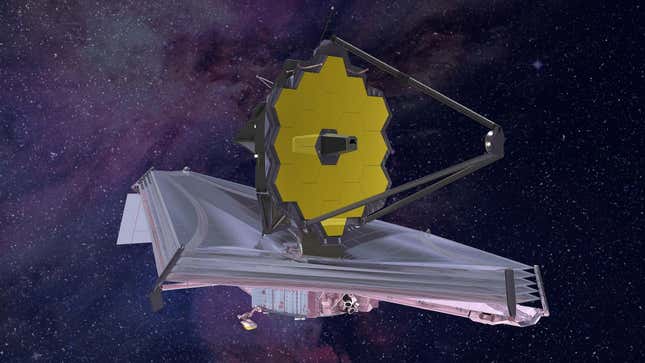
NASA, after a slight technical delay, has now tightened all five layers of the Webb Telescope’s protective sunshield.
The tensioning of the first three layers began early Monday, in a process that lasted for nearly six hours. The remaining two layers—the ones farthest from the Sun—were tightened today, NASA announced in a tweet. This is welcome news, as the successful deployment of the sunshield sets the stage for the next phase of the mission: deploying the telescope’s gigantic mirror.
Measuring 47 feet (14.3 meters) across and 70 feet (21.3 meters) long, the kite-shaped sunshield will protect Webb from stellar radiation and minimize interference caused by the observatory’s instrumentation. Webb needs this shield to function properly, making this a critically important phase of the mission—but getting all five membranes to stretch out tight is more difficult than it sounds.
James Cooper, NASA’s Webb sunshield manager, said “complex interactions between the structures, the tensioning mechanisms, the cables and the membranes,” is what makes this phase so challenging, as he explained in a NASA blog post. “This was the hardest part to test on the ground,” he added, saying the Northrop Grumman and NASA team is “doing great work.”
At a briefing with reporters on Monday, Bill Ochs, Webb project manager at NASA’s Goddard Space Flight Center, said around three-quarters of the observatory’s 344 potential points of failure will be retired once the sunshield is fully tensioned.
Last week, the deployment of two booms on either side of the observatory took longer than expected, so controllers were given a day off on January 1 to rest. Tightening of the sunshield was then scheduled for January 2, but NASA instead used the day to resolve a pair of minor issues. Specifically, the team had to rebalance Webb’s solar array to draw more power and re-orient the spacecraft to reduce the amount of sunlight hitting the motors used for tensioning, according to NASA.
The delay also provided an opportunity for the team to study how Webb is behaving in its new space environment. “Nothing we can learn from simulations on the ground is as good as analyzing the observatory when it’s up and running,” Ochs explained in a post on January 2. “Now is the time to take the opportunity to learn everything we can about its baseline operations.”
The brief pause is not a problem, as the team is not currently under any kind of time pressure; NASA says “flexibility [is] built into the timeline.” The next step now is to deploy the tripod holding the secondary mirror.
Those minor glitches aside, everything seems to be going exceptionally well, knock on wood. As an added bonus, the precision of the Webb launch means this historic mission could last for more than 10 years, owing to the fuel savings. The observatory is expected to enter into the science phase of its mission in approximately six months, at which time it will gaze upon the oldest galaxies in the universe, look for new exoplanets, and scan distant atmospheres in search of extraterrestrial life.
More: Here’s what could still go wrong with the Webb space telescope.